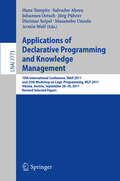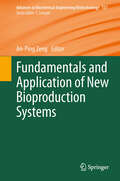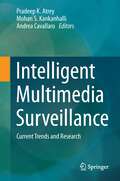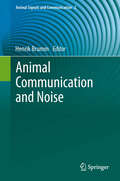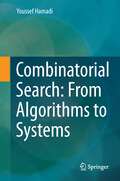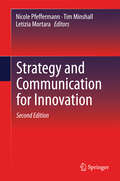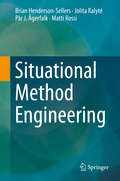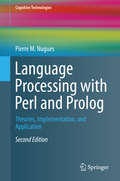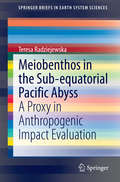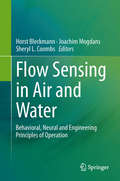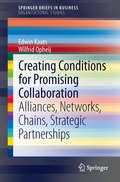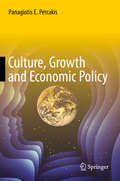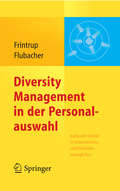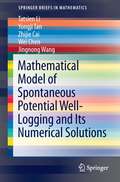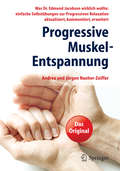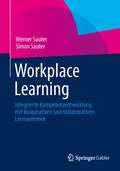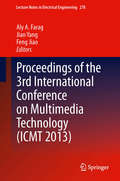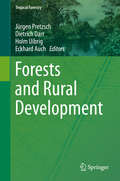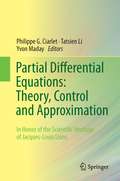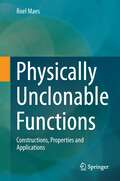- Table View
- List View
Applications of Declarative Programming and Knowledge Management: 19th International Conference, INAP 2011, and 25th Workshop on Logic Programming, WLP 2011, Vienna, Austria, September 28-30, 2011, Revised Selected Papers (Lecture Notes in Computer Science #7773)
by Hans Tompits Salvador Abreu Johannes Oetsch Jörg Pührer Dietmar Seipel Masanobu Umeda Armin WolfThis book constitutes revised selected papers of the 19th International Conference on Applications of Declarative Programming and Knowledge Management, INAP 2011, and the 25th Workshop on Logic Programming, WLP 2011, held in Vienna, Austria, in September 2011. The 19 papers presented in this volume were carefully reviewed and selected from 27 papers presented at the conference and initially a total of 35 submissions. The book also contains the papers of two invited talks. The papers are organized in topical sections on languages; answer-set programming and abductive reasoning; constraints and logic programming; answer-set programming and model expansion; application papers; and system descriptions.
Fundamentals and Application of New Bioproduction Systems
by An-Ping ZengPrinting Peptide Arrays with a Complementary Metal Oxide Semiconductor Chip, by Felix F. Loeffler, Yun-Chien Cheng, Bastian Muenster, Jakob Striffler, Fanny C. Liu, F. Ralf Bischoff, Edgar Doersam, Frank Breitling, Alexander Nesterov-Mueller. Protein Engineering as a Tool for the Development of Novel Bio production Systems, by Uwe T. Bornscheuer. Compartmentalization and Metabolic Channeling for Multienzymatic Biosynthesis: Practical Strategies and Modeling Approaches, by U. Jandt, C. You, Y. H. -P. Zhang, A. -P. Zeng. Cell-Free Systems: Functional Modules for Synthetic and Chemical Biology, by Marlitt Stech, Andreas K. Brödel, Robert B. Quast, Rita Sachse, Stefan Kubick. New Bio production Systems: From Molecular Circuits to Novel Reactor Concepts in Cell-Free Biotechnology, by Steffen Rupp. Cell-free Biosystems in the Production of Electricity and Bioenergy, by Zhiguang Zhu, Tsz Kin Tam, Y. -H. Percival Zhang. In Vitro Multi enzymatic Reaction Systems for Biosynthesis, by Inés Ardao, Ee Taek Hwang, An-Ping Zeng. Directed Multistep Biocatalysis Using Tailored Permeabilized Cells, by Steffen Krauser, Christian Weyler, Lisa Katharina Blaß, Elmar Heinzle.
Intelligent Multimedia Surveillance
by Andrea Cavallaro Pradeep K. Atrey Mohan S. KankanhalliIntelligent multimedia surveillance concerns the analysis of multiple sensing inputs including video and audio streams, radio-frequency identification (RFID), and depth data. These data are processed for the automated detection and tracking of people, vehicles, and other objects. The goal is to locate moving targets, to understand their behavior, and to detect suspicious or abnormal activities for crime prevention. Despite its benefits, there is societal apprehension regarding the use of such technology, so an important challenge in this research area is to balance public safety and privacy. This edited book presents recent findings in the field of intelligent multimedia surveillance emerging from disciplines such as multimedia computing, computer vision, and artificial intelligence. It consists of nine chapters addressing intelligent video surveillance, video analysis of crowds, privacy issues in intelligent multimedia surveillance, RFID technology for localization of objects, object tracking using visual saliency information, estimating multiresolution depth using active stereo vision, and performance evaluation for video surveillance systems. The book will be of value to researchers and practitioners working on related problems in security, multimedia, and artificial intelligence.
Prediction and Classification of Respiratory Motion
by Yuichi Motai Suk Jin LeeThis book describes recent radiotherapy technologies including tools for measuring target position during radiotherapy and tracking-based delivery systems. This book presents a customized prediction of respiratory motion with clustering from multiple patient interactions. The proposed method contributes to the improvement of patient treatments by considering breathing pattern for the accurate dose calculation in radiotherapy systems. Real-time tumor-tracking, where the prediction of irregularities becomes relevant, has yet to be clinically established. The statistical quantitative modeling for irregular breathing classification, in which commercial respiration traces are retrospectively categorized into several classes based on breathing pattern are discussed as well. The proposed statistical classification may provide clinical advantages to adjust the dose rate before and during the external beam radiotherapy for minimizing the safety margin. In the first chapter following the Introduction to this book, we review three prediction approaches of respiratory motion: model-based methods, model-free heuristic learning algorithms, and hybrid methods. In the following chapter, we present a phantom study--prediction of human motion with distributed body sensors--using a Polhemus Liberty AC magnetic tracker. Next we describe respiratory motion estimation with hybrid implementation of extended Kalman filter. The given method assigns the recurrent neural network the role of the predictor and the extended Kalman filter the role of the corrector. After that, we present customized prediction of respiratory motion with clustering from multiple patient interactions. For the customized prediction, we construct the clustering based on breathing patterns of multiple patients using the feature selection metrics that are composed of a variety of breathing features. We have evaluated the new algorithm by comparing the prediction overshoot and the tracking estimation value. The experimental results of 448 patients' breathing patterns validated the proposed irregular breathing classifier in the last chapter.
Animal Communication and Noise (Animal Signals and Communication #2)
by Henrik BrummThe study of animal communication has led to significant progress in our general understanding of motor and sensory systems, evolution, and speciation. However, one often neglected aspect is that signal exchange in every modality is constrained by noise, be it in the transmission channel or in the nervous system. This book analyses whether and how animals can cope with such constraints, and explores the implications that noise has for our understanding of animal communication. It is written by leading biologists working on different taxa including insects, fish, amphibians, lizards, birds, and mammals. In addition to this broad taxonomic approach, the chapters also cover a wide array of research disciplines: from the mechanisms of signal production and perception, to the behavioural ecology of signalling, the evolution of animal communication, and conservation issues. This volume promotes the integration of the knowledge gained by the diverse approaches to the study of animal communication and, at the same time, highlights particularly interesting fields of current and future research.
Combinatorial Search: From Algorithms To Systems
by Youssef HamadiAlthough they are believed to be unsolvable in general, tractability results suggest that some practical NP-hard problems can be efficiently solved. Combinatorial search algorithms are designed to efficiently explore the usually large solution space of these instances by reducing the search space to feasible regions and using heuristics to efficiently explore these regions. Various mathematical formalisms may be used to express and tackle combinatorial problems, among them the constraint satisfaction problem (CSP) and the propositional satisfiability problem (SAT). These algorithms, or constraint solvers, apply search space reduction through inference techniques, use activity-based heuristics to guide exploration, diversify the searches through frequent restarts, and often learn from their mistakes. In this book the author focuses on knowledge sharing in combinatorial search, the capacity to generate and exploit meaningful information, such as redundant constraints, heuristic hints, and performance measures, during search, which can dramatically improve the performance of a constraint solver. Information can be shared between multiple constraint solvers simultaneously working on the same instance, or information can help achieve good performance while solving a large set of related instances. In the first case, information sharing has to be performed at the expense of the underlying search effort, since a solver has to stop its main effort to prepare and commu nicate the information to other solvers; on the other hand, not sharing information can incur a cost for the whole system, with solvers potentially exploring unfeasible spaces discovered by other solvers. In the second case, sharing performance measures can be done with little overhead, and the goal is to be able to tune a constraint solver in relation to the characteristics of a new instance - this corresponds to the selection of the most suitable algorithm for solving a given instance. The book is suitable for researchers, practitioners, and graduate students working in the areas of optimization, search, constraints, and computational complexity.
Strategy and Communication for Innovation
by Nicole Pfeffermann Tim Minshall Letizia MortaraThe innovation economy sets new standards for global business and requires efficient innovation management to plan, execute and evaluate innovation activities, establish innovation capability and coordinate resources and capacities for innovation on an intra- and inter-organizational level. Communication has become a critical factor underpinning successful innovation. As a new communication field, innovation communication facilitates the successful launches of new products and services, the establishment of stakeholder relationships, and the strengthening of corporate reputation in the long-run. Consequently, firms today need to develop a strong portfolio of communication tools as an integral part of their strategic innovation management activities. This new edition mainly concentrates on emerging approaches and methods for integrating communication as part of strategic innovation management. A key theme is the provision of an integrated perspective to bridge the gap between innovation management and communication management at both strategic and operational levels. This book makes an important contribution to this evolving academic domain by providing multiple perspectives on the latest research on innovation communication and strategic open innovation. It also provides guidance for managers seeking to understand the diverse ways by which they can leverage communication to support successful innovation.
Synthesis of Saturated Oxygenated Heterocycles II
by Janine CossyThe series Topics in Heterocyclic Chemistry presents critical reviews on present and future trends in the research of heterocyclic compounds. Overall the scope is to cover topics dealing with all areas within heterocyclic chemistry, both experimental and theoretical, of interest to the general heterocyclic chemistry community. The series consists of topic related volumes edited by renowned editors with contributions of experts in the field.
Situational Method Engineering
by Pär J. Ågerfalk Brian Henderson-Sellers Jolita Ralyté Matti RossiWhile previously available methodologies for software - like those published in the early days of object technology - claimed to be appropriate for every conceivable project, situational method engineering (SME) acknowledges that most projects typically have individual characteristics and situations. Thus, finding the most effective methodology for a particular project needs specific tailoring to that situation. Such a tailored software development methodology needs to take into account all the bits and pieces needed for an organization to develop software, including the software process, the input and output work products, the people involved, the languages used to describe requirements, design, code, and eventually also measures of success or failure. The authors have structured the book into three parts. Part I deals with all the basic concepts, terminology and overall ideas underpinning situational method engineering. As a summary of this part, they present a formal meta-model that enables readers to create their own quality methods and supporting tools. In Part II, they explain how to implement SME in practice, i. e. , how to find method components and put them together and how to evaluate the resulting method. For illustration, they also include several industry case studies of customized or constructed processes, highlighting the impact that high-quality engineered methods can have on the success of an industrial software development. Finally, Part III summarizes some of the more recent and forward-looking ideas. This book presents the first summary of the state of the art for SME. For academics, it provides a comprehensive conceptual framework and discusses new research areas. For lecturers, thanks to its step-by-step explanations from basics to the customization and quality assessment of constructed methods, it serves as a solid basis for comprehensive courses on the topic. For industry methodologists, it offers a reference guide on features and technologies to consider when developing in-house software development methods or customising and adopting off-the-shelf ones.
Language Processing with Perl and Prolog
by Pierre M. NuguesThe areas of natural language processing and computational linguistics have continued to grow in recent years, driven by the demand to automatically process text and spoken data. With the processing power and techniques now available, research is scaling up from lab prototypes to real-world, proven applications. This book teaches the principles of natural language processing, first covering practical linguistics issues such as encoding and annotation schemes, defining words, tokens and parts of speech and morphology, as well as key concepts in machine learning, such as entropy, regression and classification, which are used throughout the book. It then details the language-processing functions involved, including part-of-speech tagging using rules and stochastic techniques, using Prolog to write phase-structure grammars, syntactic formalisms and parsing techniques, semantics, predicate logic and lexical semantics and analysis of discourse and applications in dialogue systems. A key feature of the book is the author's hands-on approach throughout, with sample code in Prolog and Perl, extensive exercises, and a detailed introduction to Prolog. The reader is supported with a companion website that contains teaching slides, programs and additional material. The second edition is a complete revision of the techniques exposed in the book to reflect advances in the field the author redesigned or updated all the chapters, added two new ones and considerably expanded the sections on machine-learning techniques.
Meiobenthos in the Sub-equatorial Pacific Abyss
by Teresa RadziejewskaAgainst the backdrop of the environmental setting of the subequatorial NE Pacific abyssal plain, the book will characterise the meiobenthos as an ecological category in the deep sea and introduce research lines meiobenthic studies are applied to, including environmental assessments of human-induced disturbance of the deep seafloor. It will proceed to present an overview of the current knowledge on the meiobenthos of the area of concern and will discuss general considerations regarding the use of meiobenthos as indicator of seafloor disturbance. It will address the question of deep-sea mineral resources development versus benthic communities and will present an overview of field studies ("experiments") aimed at assessing the magnitude of potential impact associated with seafloor resources development (polymetallic nodule mining in particular) in the Pacific.
Flow Sensing in Air and Water
by Horst Bleckmann Joachim Mogdans Sheryl L. CoombsIn this book, leading scientists in the fields of sensory biology, neuroscience, physics and engineering explore the basic operational principles and behavioral uses of flow sensing in animals and how they might be applied to engineering applications such as autonomous control of underwater or aerial vehicles. Although humans possess no flow-sensing abilities, countless aquatic (e. g. fish, cephalopods and seals), terrestrial (e. g. crickets and spiders) and aerial (e. g. bats) animals have flow sensing abilities that underlie remarkable behavioral feats. These include the ability to follow silent hydrodynamic trails long after the trailblazer has left the scene, to form hydrodynamic images of their environment in total darkness, and to swim or fly efficiently and effortlessly in the face of destabilizing currents and winds.
Creating Conditions for Promising Collaboration: Alliances, Networks, Chains, Strategic Partnerships (SpringerBriefs in Business)
by Edwin Kaats Wilfrid OpheijThis publication focuses on the conditions for promising collaboration. Collaboration is becoming a dominant instrument in today's economy and society and manifests itself in many shapes and forms. It is a challenging instrument which still isn't very well understood and poses the business community in front of a number of challenging dilemma's. We position collaboration as a multidisciplinary phenomenon and - based on years of research and as reflective practitioners - offer a comprehensive model for analyzing and designing collaborative processes that is both scientifically rooted and applicable in practice. A better understanding of collaborative processes will enhance the success of alliances, networks, chains and strategic partnerships. In addition to this we look to the future of organizing from a collaborative perspective and address the challenges ahead.
Culture, Growth and Economic Policy
by Panagiotis E. PetrakisIt is a wide-spread belief that the cultural background inhered in a society affects the requirements of economic development. This relationship requires theoretical and empirical justification. The present book provides this together with an analysis of the development of cultural background itself. Cultural background is embodied in political institutions, in transactions, knowledge, incentives, in social capital, even in the tangibles of the economy. Thus, economic development is shaped and the rate of growth is affected. Conversely, economic development affects cultural background. When this interaction takes place at a non-developmental cultural background level, which is associated with low growth rates, then a growth trap is formed. Within such a growth trap, economic policy (public and monetary) is relatively deactivated and the conditions influencing the change in cultural background and its timing are of primary importance.
Laser
by Jürgen Eichler Hans Joachim EichlerDiese grundlegende Einf#65533;hrung in die Physik und Technik der Laser informiert #65533;ber - Funktion, Bauformen und Emissionseigenschaften der Laser, - Lasertypen, optische Komponenten und Strahlf#65533;hrung, - Anwendungen in Materialbearbeitung, Medizin und Messtechnik. Die 8. Auflage dieses etablierten Lehrbuchs ber#65533;cksichtigt neueste Entwicklungen: Hochleistungsdioden- und Festk#65533;rperlaser f#65533;r ultraviolette, sichtbare und infrarote Strahlung, Faserlaser zur Erzeugung ultrakurzer Lichtimpulse und R#65533;ntgenstrahlung aus Freie-Elektronen-Lasern, sowie Anwendungen in der Laserchirurgie, medizinischen Diagnostik und Biophotonik.
Diversity Management in der Personalauswahl
by Andreas Frintrup Brigitte FlubacherDie Rahmenbedingungen für die Personalauswahl in Unternehmen und Behörden hat sich dramatisch verändert - und wird sich weiter verändern: Qualifizierte Fachkräfte sind branchenübergreifend immer schwerer zu finden. Gleichzeitig steigt in Deutschland die Zahl gut qualifizierter Migranten. Eine zeitgemäße Personalauswahl muss hierauf Antworten entwickeln, damit dieses Qualifikationsreservoir auch nutzbar gemacht werden kann und geeignete ausländische Bewerber nicht an formalen Stufen des Einstellungsprozesses oder an den noch ausbaubedürftigen Sprachkenntnissen scheitern. Die Autoren erklären kompakt und praxisnah, wie eine Erhöhung der Zugangschancen von geeigneten Bewerbern mit Migrationshintergrund erreicht und gleichzeitig die Qualität der Auswahlentscheidung in Bezug auf die künftige Erfüllung der beruflichen Anforderungen sichergestellt werden kann. So beschreiben sie vor diesem Hintergrund systematisch alle wichtigen Instrumente und Schritte des personaldiagnostischen Prozesses. - Daneben werden Grundlagen zu personaldiagnostischen und juristischen Fragen vermittelt und auch moderne, webbasierte Bewerbungsprozesse berücksichtigt. Dieses Buch hilft, die Personalauswahl besser auf das Zukunftserfordernis Diversity auszurichten. Personaler können damit einen Beitrag leisten zur kulturellen Vielfalt und Leistungsfähigkeit der Organisation, und darüber hinaus zu gesellschaftlicher Prosperität und sozialer Sicherheit.
Foundations of Computational Linguistics
by Roland HausserThe central task of a future-oriented computational linguistics is the development of cognitive machines which humans can freely talk with in their respective natural language. In the long run, this task will ensure the development of a functional theory of language, an objective method of verification, and a wide range of practical applications. Natural communication requires not only verbal processing, but also non-verbal perception and action. Therefore the content of this textbook is organized as a theory of language for the construction of talking robots. The main topic is the mechanism of natural language communication in both the speaker and the hearer. In the third edition the author has modernized the text, leaving the overview of traditional, theoretical, and computational linguistics, analytic philosophy of language, and mathematical complexity theory with their historical backgrounds intact. The format of the empirical analyses of English and German syntax and semantics has been adapted to current practice; and Chaps. 22-24 have been rewritten to focus more sharply on the construction of a talking robot.
Mathematical Model of Spontaneous Potential Well-Logging and Its Numerical Solutions
by Wei Chen Tatsien Li Yongji Tan Zhijie Cai Jingnong WangSpontaneous potential (SP) well-logging is one of the most common and useful well-logging techniques in petroleum exploitation. This monograph is the first of its kind on the mathematical model of spontaneous potential well-logging and its numerical solutions. The mathematical model established in this book shows the necessity of introducing Sobolev spaces with fractional power, which seriously increases the difficulty of proving the well-posedness and proposing numerical solution schemes. In this book, in the axisymmetric situation the well-posedness of the corresponding mathematical model is proved and three efficient schemes of numerical solution are proposed, supported by a number of numerical examples to meet practical computation needs.
People, Problems, and Proofs
by Richard J. Lipton Kenneth W. ReganPeople, problems, and proofs are the lifeblood of theoretical computer science. Behind the computing devices and applications that have transformed our lives are clever algorithms, and for every worthwhile algorithm there is a problem that it solves and a proof that it works. Before this proof there was an open problem: can one create an efficient algorithm to solve the computational problem? And, finally, behind these questions are the people who are excited about these fundamental issues in our computational world. In this book the authors draw on their outstanding research and teaching experience to showcase some key people and ideas in the domain of theoretical computer science, particularly in computational complexity and algorithms, and related mathematical topics. They show evidence of the considerable scholarship that supports this young field, and they balance an impressive breadth of topics with the depth necessary to reveal the power and the relevance of the work described. Beyond this, the authors discuss the sustained effort of their community, revealing much about the culture of their field. A career in theoretical computer science at the top level is a vocation: the work is hard, and in addition to the obvious requirements such as intellect and training, the vignettes in this book demonstrate the importance of human factors such as personality, instinct, creativity, ambition, tenacity, and luck. The authors' style is characterize d by personal observations, enthusiasm, and humor, and this book will be a source of inspiration and guidance for graduate students and researchers engaged with or planning careers in theoretical computer science.
Progressive Muskel-Entspannung
by Andrea Naeher-Zeiffer Jürgen Naeher-ZeifferProgressive Muskel-Entspannung. Die gesundheitsfördernde Wirkung dieser weit verbreiteten Methode zur Stressbewältigung ist bekannt: Sie hilft Muskelverspannungen zu lösen, körperliche Anspannung und psychischen Stress abzubauen, Schmerzen vorzubeugen und Schmerzzustände zu lindern. Dieses Buch, als Textanleitung zum selbst Erlernen und für Gruppenarbeit geeignet, bietet eine neue, interessante Perspektive. Was Dr. Edmund Jacobson wirklich wollte, zeigt ,,das Original" der ,,Progressiven Relaxation", wie von Edmund Jacobson ursprünglich konzipiert (und zum ersten Mal in dieser Form deutschsprachig veröffentlicht). Es ist ein einfaches, alltagsnahes Übungsprogramm, das überall und jederzeit bequem durchgeführt werden kann. Der besondere, für Jacobson wesentliche Effekt: Die Art, wie der Wechsel von Anspannen und Entspannen der einzelnen Körperteile geübt wird, sensibilisiert zunehmend die Körperwahrnehmung. Als Übender lernt man, auch im Alltag bereits bei sich ankündigendem Stress eine aufkommende (muskuläre und psychische) Anspannung spontan zu lösen - und diese Reaktion zu ,,automatisieren". Verhalten und Handeln in Alltagsituationen werden damit entspannter und kräfteschonender.
Workplace Learning
by Werner Sauter Simon SauterSocial Business erfordert kollaborative Unternehmen, in denen Arbeiten und Lernen wieder zusammen wachsen. Auf der Grundlage einer Analyse der voraussichtlichen Entwicklung der Rahmenbedingungen der Arbeitswelt und der betrieblichen Lernsysteme in der Zukunft werden in diesem Werk die Anforderungen an innovative Kompetenzentwicklungssysteme mit E-Learning, Blended Learning , Social Learning und Workplace Learning abgeleitet. Es vermittelt praxiserprobte Lösungskonzepte und Entscheidungshilfen für die Entwicklung und Einführung zukunftsorientierter Lernsysteme mit dem Ziel, eine Kultur kollaborativen Arbeitens und Lernens am ,,Workplace" zu initiieren.
Proceedings of the 3rd International Conference on Multimedia Technology (ICMT #2013)
by Aly A. Farag Jian Yang Feng JiaoProceedings of the 3rd International Conference on Multimedia Technology (ICMT2013) focuses on both the theory and applications of multimedia technology. The recent advances, new research findings and applications in the fields of theoretical, experimental and applied image & video processing and multimedia technology presented at the conference are brought together in this book. It will serve as a valuable reference for scientists and engineers working in multimedia and related fields. Prof. Aly A. Farag works at the University of Louisville, USA; Prof. Jian Yang works at Tsinghua University, China; Dr. Feng Jiao works at Nanjing University of Information Science & Technology, China.
Forests and Rural Development
by Jürgen Pretzsch Dietrich Darr Holm Uibrig Eckhard AuchThis book provides an overview of the complex challenges and opportunities related to forest-based rural development in the tropics and subtropics. Applying a socio-ecological perspective, the book traces the changing paradigms of forestry in rural development throughout history, summarizes the major aspects of the rural development challenge in forest areas and documents innovative approaches in fields such as land utilization, technology and organizational development, rural advisory services, financing mechanisms, participative planning and forest governance. It brings together scholars and practitioners dealing with the topics from various theoretical and practical angles. Calling for an approach that carefully balances market forces with government intervention, the book shows that forests in rural areas have the potential to provide a solid foundation for a green global economy.
Partial Differential Equations: Theory, Control and Approximation
by Tatsien Li Philippe G. Ciarlet Yvon MadayThis book collects papers mainly presented at the "International Conference on Partial Differential Equations: Theory, Control and Approximation" (May 28 to June 1, 2012 in Shanghai) in honor of the scientific legacy of the exceptional mathematician Jacques-Louis Lions. The contributors are leading experts from all over the world, including members of the Academies of Sciences in France, the USA and China etc. , and their papers cover key fields of research, e. g. partial differential equations, control theory and numerical analysis, that Jacques-Louis Lions created or contributed so much to establishing.
Physically Unclonable Functions
by Roel MaesPhysically unclonable functions (PUFs) are innovative physical security primitives that produce unclonable and inherent instance-specific measurements of physical objects; in many ways they are the inanimate equivalent of biometrics for human beings. Since they are able to securely generate and store secrets, they allow us to bootstrap the physical implementation of an information security system. In this book the author discusses PUFs in all their facets: the multitude of their physical constructions, the algorithmic and physical properties which describe them, and the techniques required to deploy them in security applications. The author first presents an extensive overview and classification of PUF constructions, with a focus on so-called intrinsic PUFs. He identifies subclasses, implementation properties, and design techniques used to amplify submicroscopic physical distinctions into observable digital response vectors. He lists the useful qualities attributed to PUFs and captures them in descriptive definitions, identifying the truly PUF-defining properties in the process, and he also presents the details of a formal framework for deploying PUFs and similar physical primitives in cryptographic reductions. The author then describes a silicon test platform carrying different intrinsic PUF structures which was used to objectively compare their reliability, uniqueness, and unpredictability based on experimental data. In the final chapters, the author explains techniques for PUF-based entity identification, entity authentication, and secure key generation. He proposes practical schemes that implement these techniques, and derives and calculates measures for assessing different PUF constructions in these applications based on the quality of their response statistics. Finally, he presents a fully functional prototype implementation of a PUF-based cryptographic key generator, demonstrating the full benefit of using PUFs and the efficiency of the processing techniques described. This is a suitable introduction and reference for security researchers and engineers, and graduate students in information security and cryptography.
